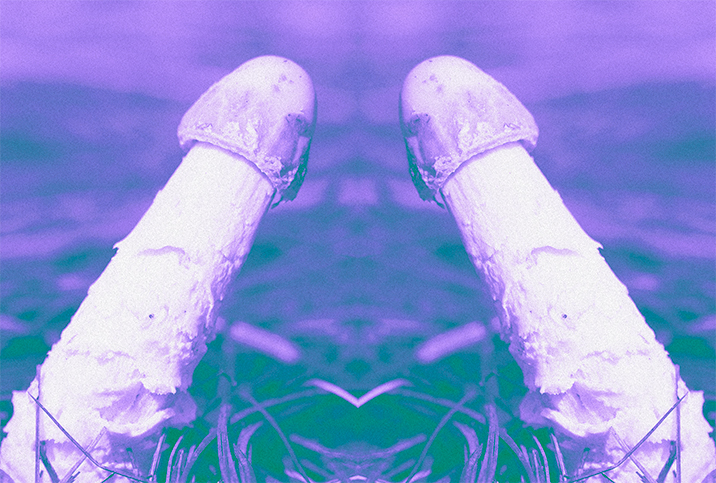The Case of the Duplicate Penis

While many men at some point in their life have worried about the size of their penis, very few have ever had to worry about the number of them. Diphallia, or the presence of two penises, is an incredibly rare congenital anomaly that affects male babies. The first reported case dates back to 1609. While scary for parents of a baby born with this genetic condition, diphallia affects only 1 of every 5 million to 6 million baby boys, and only about 100 cases have been reported worldwide in medical literature.
Given the few studied cases of diphallia, the causes are not well understood. Some theories suggest this irregularity may be caused by a woman's exposure to drugs or an infection during the first month of pregnancy. Others suggest it is hereditary and completely out of an individual's control. The dearth of cases, however, makes it impossible to make any conclusive statements.
Diphallia manifests itself in a number of different ways. No two cases are exactly alike, and having a perfect duplicate penis is very rare; when it occurs, it is known as true complete diphallia. Cases where the extra penis is not perfect—usually, it is smaller and more rudimentary—are known as true partial diphallia.
The most common form of the condition is bifid diphallia, but you need to understand a little about the anatomy of the penis to know why it's different from true diphallia. A normal penis has two columns of soft tissue known as the corpus cavernosa and their function is to fill with blood to help facilitate erections. However, there is only one corpus cavernosum per penis in cases of bifid diphallia.
Both classifications of diphallia can be accompanied by other birth anomalies, and true diphallia is usually accompanied by more severe malformations. Each case of diphallia produces unique anatomy, and treatment differs from one patient to another. For instance, some can have one or more other irregularities, generally in the pelvic region, while others could have anomalies in the urinary, reproductive, gastrointestinal and musculoskeletal systems.
Treatment is not always necessary
"Often the disorder can be corrected when the child is young with surgery. Sometimes the condition is minor and does not even need surgery, such as a cleft scrotum," said Paul Thompson, M.D., a Fort Worth, Texas-based urologist and surgeon and the chief medical officer for Launch Medical, a men's sexual health company in Los Angeles. "For severe cases, surgery is recommended. But sometimes it can be barely noticeable, and in these cases, surgery can cause more problems than it solves, so it can be left alone."
Men with two penises are living unaffected lives
"People with diphallia can live normal lives, as it is not a terminal condition. It can be fixed," said Justin Houman, M.D., a medical director at Bastion Health and a board-certified urologist at Tower Urology in Los Angeles.
Other than the aesthetics, diphallia may not be a cause for concern unless it is tied to other birth defects. Surgery is the go-to treatment, if it's deemed necessary, and usually involves the excision of the nonfunctional penis, leaving behind the functional penis.
The procedure differs depending on the classification of the diphallia and its accompanying malformations. The procedure is usually conducted in multiple surgeries over a period of time determined by how many anomalies accompany the duplicate penis. Some cases of diphallia have been treated after only a single surgery, but this is not usually the case. Generally speaking, treatment is handled by a large team of doctors in order to devise the safest and least invasive surgical plan.
In day-to-day life, functionality is more important than aesthetics. A recent case in Brazil illustrates this point. The baby's doctors originally planned to remove the smaller of the two phalluses but opted to remove the larger one after the infant's mother pointed out that he could urinate only from the smaller penis.
"The penis has two functions: urination and sexual function. Ideally, it would be a situation where the one being left behind could perform both functions, but that is not always the case," Houman said. "Sexual function can be addressed with different procedures later in life. Correcting abnormal urinating is surgically more difficult with more complications. So it does make sense to leave the penis that functions better from a urinary standpoint."
Thompson agreed.
"You want to take the least invasive route possible," he said. "To remove the other would involve reconstructing the urinary tract, which is far more invasive, and the more invasive, the higher probability of complications during surgery as well as later in life."
Is intercourse possible?
Depending on the specifics of the individual case, it is possible for a man with diphallia to have sexual intercourse and a healthy sex life. In 2014, Reddit user doubledickdude went viral when he posted an extremely educational "ask me anything" thread. Anyone wondering if it's possible for a man with diphallia to have sex can learn a lot from this thread, in which he wrote:
"I've been in a serious relationship with a girl and a guy for a while now. I call it monogamous because we are exclusive. She enjoys it. The three girls before her enjoyed it. It's sort of made a few run screaming in the past. Usually, the ones I get to know well before we date are cool with it. I don't talk about it otherwise. Like, if I'm not going to have sex with you, you won't know I've got two dicks. LOL."
Diphallia is incredibly rare and does not have any adverse effects on a baby as long as it is not accompanied by other severe malformations. Surgical treatment options are available to address most issues that may accompany the condition, but surgery is not always necessary or wanted, and it is possible to exist in this world with two penises.


















